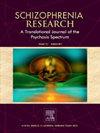个人和环境社会经济地位与心理健康相关污名的关系:来自中国精神病院工作人员的证据
IF 3.5
2区 医学
Q1 PSYCHIATRY
引用次数: 0
摘要
背景:医疗服务提供者中与精神健康相关的耻辱感阻碍了高质量的护理和患者的治疗效果。社会经济地位(SES)是一个关键因素。现有的研究表明,个体社会地位与病耻感之间的关联在人群中并不一致,而且关于个体社会地位与环境社会地位如何相互作用形成病耻感的证据仍然有限。本研究旨在(1)描述中国精神病院工作人员的心理健康污名;(2)探讨个体和环境SES与病耻感的关系;(3)考察个体社会经济地位与环境社会经济地位的相互作用。方法对全国6个地区精神病院工作人员的病耻感及相关因素进行在线调查。总共有3323名参与者被纳入分析。社会经济地位分为个体社会经济地位(受教育程度和年收入)和结构社会经济地位(地区教育水平和地区收入水平)。采用多水平混合效应线性回归检验相关性和相互作用。结果在15 ~ 105分的量表中,中国精神科医院工作人员心理健康相关污名的平均得分为53.3分。在个体SES中,受教育程度与心理健康相关的病耻感呈正相关(学士学位:调整后的β = 3.252, p <;0.001;硕士及以上学历:经调整β = 3.824, p = 0.004)。在环境SES中,心理健康相关污名与地区教育水平呈负相关(调整后的β = 3.863, p = 0.012),与地区收入水平呈正相关(调整后的β = - 3.712, p = 0.018)。区域教育水平调节了个体社会经济地位与心理健康相关病耻感之间的正相关(调整后的β = - 2.226, p = 0.049)。结论社会经济地位较高的精神科工作人员可能最需要干预措施来减少与心理健康相关的耻辱感。加强精神科工作人员与公众之间的接触和互动,对减轻污名也至关重要。本文章由计算机程序翻译,如有差异,请以英文原文为准。
Association of individual and environmental socioeconomic status with mental health-related stigma: Evidence from psychiatric hospital staff in China
Background
Mental health-related stigma among healthcare providers impedes quality care and patient outcomes. Socioeconomic status (SES) is a critical factor. Existing studies suggest inconsistent associations between individual SES and stigma across populations, and evidence on how individual SES and environmental SES interact to shape stigma remains limited. This study aimed to (1) describe the mental health-related stigma of psychiatric hospital staff in China; (2) explore the association of individual and environmental SES with stigma; (3) examine the interaction between individual SES and environmental SES.
Methods
The data were obtained from an online survey of stigma and related factors among psychiatric hospital staff in 6 regions of China. In total, 3323 participants were included in the analysis. SES was divided into individual SES (educational attainment and annual income) and structural SES (regional education levels and regional income levels). Multilevel mixed-effects linear regression was used to examine the association and interaction.
Results
We observed that the average score of mental health-related stigma among psychiatric hospital staff in China was 53.3 on a scale of 15–105. In individual SES, a positive association was found between educational attainment and mental health-related stigma (bachelor's degree: adjusted β = 3.252, p < 0.001; master's degree or above: adjusted β = 3.824, p = 0.004). In environmental SES, mental health-related stigma was negatively associated with regional education levels (adjusted β = 3.863, p = 0.012), but positively associated with regional income levels (adjusted β = −3.712, p = 0.018). Regional education levels moderated the positive association between individual SES and mental health-related stigma (adjusted β = −2.226, p = 0.049).
Conclusion
Our findings suggest that psychiatric staff with higher SES may be in greatest need of interventions to reduce mental health-related stigma. Enhancing the contact and interaction between psychiatric staff and the public is also essential to mitigate stigma.
求助全文
通过发布文献求助,成功后即可免费获取论文全文。
去求助
来源期刊

Schizophrenia Research
医学-精神病学
CiteScore
7.50
自引率
8.90%
发文量
429
审稿时长
10.2 weeks
期刊介绍:
As official journal of the Schizophrenia International Research Society (SIRS) Schizophrenia Research is THE journal of choice for international researchers and clinicians to share their work with the global schizophrenia research community. More than 6000 institutes have online or print (or both) access to this journal - the largest specialist journal in the field, with the largest readership!
Schizophrenia Research''s time to first decision is as fast as 6 weeks and its publishing speed is as fast as 4 weeks until online publication (corrected proof/Article in Press) after acceptance and 14 weeks from acceptance until publication in a printed issue.
The journal publishes novel papers that really contribute to understanding the biology and treatment of schizophrenic disorders; Schizophrenia Research brings together biological, clinical and psychological research in order to stimulate the synthesis of findings from all disciplines involved in improving patient outcomes in schizophrenia.
 求助内容:
求助内容: 应助结果提醒方式:
应助结果提醒方式:


